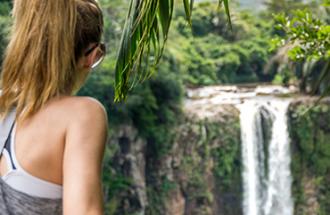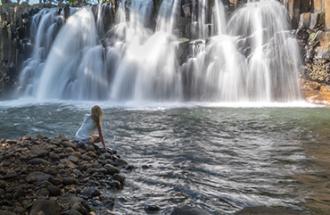The North
The North
The North of Mauritius is renowned for being a highly touristic area with beautiful sandy beaches such as Grand-Bay, Péreybère and Mont-Choisy. It is the place where tourists enjoy strolling, water sports, shopping or savouring the delights of local cuisine, whether in a restaurant or in a food truck. The North also conceals other treasures away from the coast, its historical sites and heritage will be appealing to you.
What to see in the North? The reputation of the northern beaches is not exaggerated. Péreybère, Mont Choisy, Trou aux Biches, Cap Malheureux, Pointe aux Canonniers, Bain Boeuf, all these idyllic beaches are an invitation for relaxation in the shade of Casuarina trees and sunbathing. Swimming, water sports and street-food are also on the menu. Just let yourself go. If you are there in the late afternoon, you may enjoy the sunset on some of these beaches.
One of the most popular sites in the North is the red-roofed church, Notre-Dame Auxiliatrice, in Cap Malheureux, one of the emblematic postcards of Mauritius. It is one of the favourite places to capture special moments from your holidays or honeymoon, with the sea and the islands of the north as background. Luckily enough, you will meet fishermen bringing back their catch of the day, sold right next to the church. The residents know the timing, you will see them waiting, holding their baskets, trying to get the best fish!
Further inland, in Triolet, one of the main villages of the region, there is the largest Hindu temple of the island, the Maheshwarnath Mandir, dedicated to Lord Shiva. This building, which forms part of the cultural heritage of Mauritius will trigger your curiosity. You can take pictures, while being respectful. Another major northern village is Goodlands, always vibrant, with its unmissable clothing fair on Tuesdays and Fridays, and fruit and vegetable market on Wednesdays and Saturdays. These two villages are also a true reflection of the active Mauritian life, do not hesitate to engage in conversation with the locals to better immerse yourself in the culture.
Mauritian heritage is also strongly represented in the north. Who has not heard about the legend of Paul and Virginie, immortalised by French author Bernardin de Saint Pierre? A story that ends tragically, with the sinking of the Saint Geran in the north-east. Virginie, a young girl of French nobility, and Paul, of more modest origin, grew up together and loved each other. Their story ended when Virginie returned on the Saint Géran. The ship was caught in the storm and Virginie fell in the water. Not wanting to undress by inhibition, she could not follow Paul who swam to her, and drowned because of the weight of her clothes. Paul died of sorrow shortly afterwards. A monument was erected in 1944 at Poudre d'Or for the bicentenary of the shipwreck of the Saint Géran, which really existed.
Poudre d’Or is also rich in history. It encompasses buildings dating from the colonial era such as the hospital built in the late 19th century and dedicated to pulmonary diseases, mainly for tuberculosis. A little further, take the small road that leads to the church of Sainte Philomène, also called Marie-Reine, an old stone chapel, in the middle of sugar cane fields, with a small cemetery annexed; you will feel out of time!
You can’t travel to the north without making a stopover at Pamplemousses Botanical Garden, the Sir Seewoosagur Ramgoolam Garden, located in Pamplemousses. This superb garden was created by the king’s steward, Pierre Poivre, under the administration of Mahé de Labourdonnais in the 18th century. Immerse yourself in the unique flora of Mauritius as you stroll along the shady alleys, take some pictures at the giant water lily ponds, and if you’re lucky you’ll come across a Talipot in bloom – the tree blooms every 30-80 years, and dies… The garden is also home to a variety of birds, deer and tortoises. After your visit, take a walk in the village of Pamplemousses where you can see the oldest church of the island still standing, St Francis of Assisi, founded in 1756, with its unique architecture and the statue of Paul and Virginie in the courtyard, and other vestiges of colonial and slave period.
On the other side of the motorway, in Beau Plan, L'Aventure du Sucre awaits you. Learn about the history of cane sugar in Mauritius and enjoy some sweet treats and rum tasting, and stop for a meal at the museum’s restaurant.
A visit to the Domaine de Labourdonnais is also a must. Located in Mapou, this beautiful colonial residence has been converted into a museum; the building is as interesting as its beautifully landscaped garden. There are also orchards and gardens where you can stroll. The jams and fruit pastes made from the estate’s fruit can nice as souvenir gifts.
After the fruit, let’s go for chocolate. Yes, we make chocolate in Mauritius! The Artisan chocolatier Van Ann invites you to visit its factory in Calebasses. It is the Belgian Ann Van Den Bergh who created the chocolate factory in 1992. Van Ann chocolates, made from raw materials imported from Belgium, are mainly distributed in hotels. A real treat for the sweet tooth!
Activities
The north abounds in activities, mostly water activities. Sailing enthusiasts can opt for kite surfing or windsurfing in the region of Cap Malheureux and Anse La Raie. Several catamaran or motor boat cruises are also organised around the northern islands, with stops at sea to dive or watch the dolphins. Flat Island or Gabriel Island will be the ideal places for a picnic and a swim in the clear waters around.
You want to do Scuba diving? The various certified diving centres will lead you to the most popular diving spots of the north such as the Gunner’s Coin, Holt’s Rock, and the famous Whale Rock which is about thirty meters deep; be careful, you may come across a hammerhead shark… The Balaclava Marine Park offers a completely different diving experience with snorkelling, you can discover a preserved underwater life and even swim with turtles. The Blue Safari submarine and the underwater scooter can also be a good alternative for those who do not dive, but who are still interested in exploring the underwater world!
The Mauritius Aquarium at Pointe aux Piments will appeal to young and the young at heart with its collection of 200 marine species ranging from various fish to different types of corals, and sharks. Children will also be able to interact with selected species in a designated pool.
If you stay in the north of Mauritius, cycling would definitely be an environmentally friendly and suitable option to ride along coastal or inland streets to discover local communities and their populations.
Nightlife
The north is the place to be for clubbers. Grand-Bay and its surroundings are renowned for their active nightlife; you have a wide choice between the various nightclubs, bars and pubs there. If you drive along the coastal road at night, especially on weekends, you can go around the clubs to meet the Mauritians and have fun.
Shopping
Grand-Baie is very popular for shopping among tourists. You will find whatever you are looking for, be it in the shops on the coastal road, in the shopping malls of the region or at the bazaar, ranging from clothing, accessories, handcrafts to food, among others.
Pamplemousses is also an interesting place to get souvenir gifts. There are several shops for handcrafts, local products, superbly designed boat models, and other art works.




